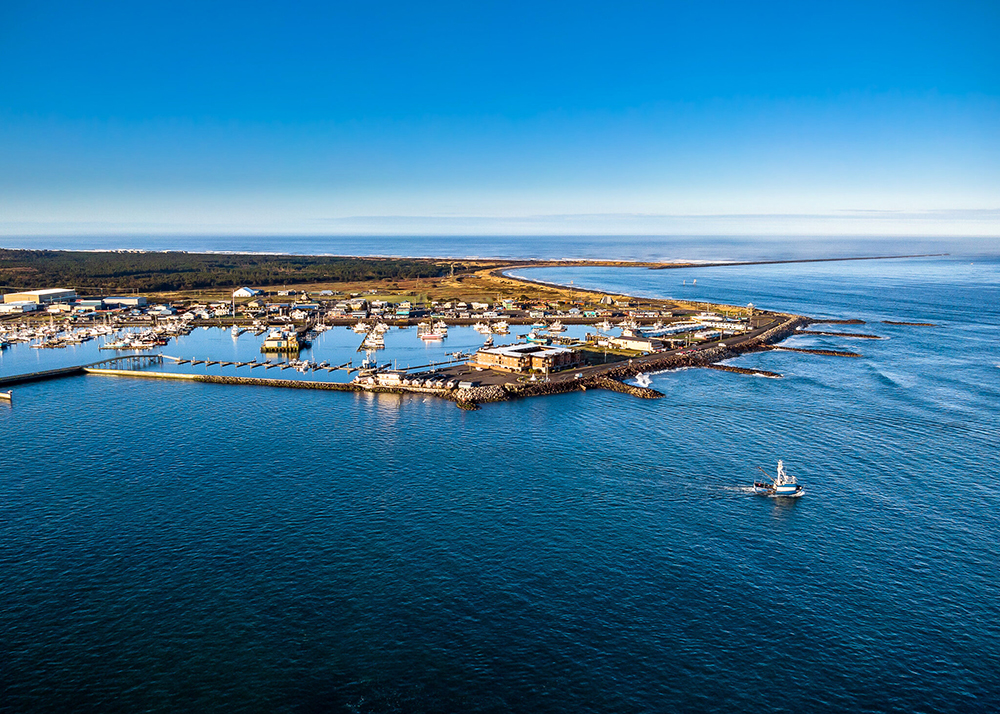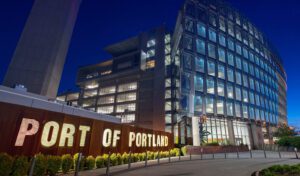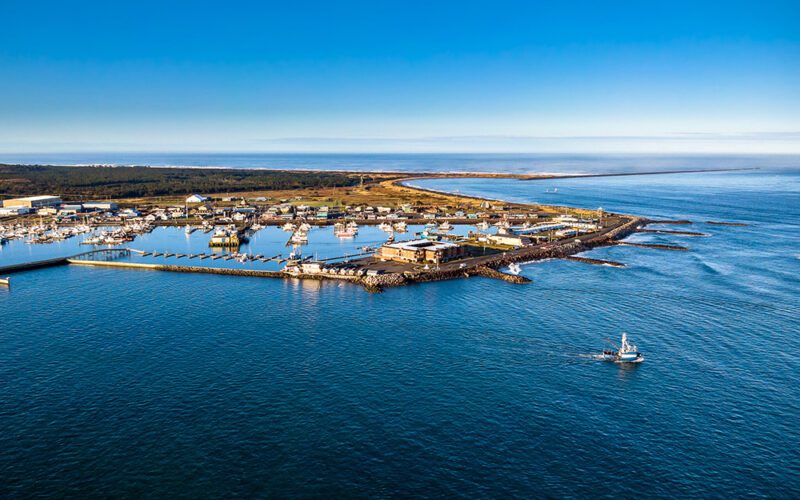
More than a century ago, the bustling Port of San Francisco dominated the U.S. West Coast’s international and domestic intercoastal deep-water trade. Meanwhile, the ports of Washington and Oregon were busy handling export cargoes such as lumber, agricultural products and coal.
Japan’s NYK steamship line had begun service between Japan and Seattle in 1896, but 13 years later a unique agreement between the Chicago, Milwaukee & St. Paul Railway Co. and Japan’s Osaka Shoshen Kaisha (OSK) Line created what was the very first ship-to-train trans-shipment agreement. It would revolutionize the international movement of goods.
Under the terms of the agreement, six 6,100-ton OSK cargo/passenger ships would call at the ports of Tacoma and Seattle on a monthly rotation.
The first ship in the new service was the Tacoma Maru, which arrived at the Port of Tacoma on her maiden voyage on Aug. 7, 1909.
Two days later, according to a contemporary newspaper account, “A very unusual train went over the Puget Sound yesterday afternoon and it attracted a great deal of attention from the few people who happened to see it as it went through. To the eye there was nothing unusual about the train, aside from the fact that it carried banners nailed onto every car which read ‘The First Train of Oriental Freight to be Carried over the Puget Sound’.”
The Tacoma Maru had arrived with cargo that filled eight boxcars with goods consigned to shippers in Milwaukee, Chicago and other inland U.S. Midwest points. Import cargoes—tea, raw silk and other products—would be off-loaded onto CM & St. P trains at the port, while export shipments of cotton, machinery and other goods would be hauled westward for the return shipment to Japan and Hong Kong.
Both eastbound and westbound transpacific and rail would be handled from shipper to consignee on both sides of the Pacific under a single bill of lading—an innovative streamlining of goods movement that, in effect, greased the links in the global intermodal supply chain that we know today.
The distinctive service grew in popularity with shippers on both sides of the Pacific, and within two years, became highly profitable, not only for OSK, but also Tacoma and Seattle.
Over the ensuing 100-plus years, both ports, and the ports of the Pacific Northwest, in general. have grown in importance despite the challenges of war, depression, labor unrest, pandemic and terminal congestion.
An Alliance
In 2015, the Pacific Northwest Seaport Alliance was formed, formally joining the operations of the once-rival Seattle and Tacoma ports into a single joint alliance. The move to align was spurred by the growing competition with the ports of Los Angeles, Long Beach and Vancouver, British Columbia, to attract cargo in the increasingly competitive transpacific trades.
Since then, both ports—which, combined, form the fourth-largest container gateway in the U.S.—have charged ahead with projects designed to improve and enhance their ability to handle box cargoes, despite a marked decline in both import and export cargo volumes over the past several months.
In January 2022, SSA Marine and the Northwest Seaport Alliance (NWSA) welcomed the first vessel call to the recently upgraded Terminal 5 in Seattle.
The Terminal 5 Modernization Program was initially launched in 2016 in an effort to expand gateway cargo capacity and enable both the ports of Seattle and Tacoma to handle the largest vessels operating in the transpacific trades.
As well as funding improvements to the terminal’s rail yard, the plan included the addition of four post-Panamax cranes at one of the terminal’s two berths. The plan’s second phase—slated for completion by the end of March 2023—includes similar improvements to the facility’s second berth.
Terminal 5 is expected to add as many as 500,000 containers lifts to its annual total when it’s fully operational.
In October, the federal government announced a grant of $17 million to further expand the Terminal 5 facility originally operated by South Korea’s now-defunct Hanjin. They grant will fund the development of new cargo storage space to reduce future backlogs and add additional truck lanes and scales to improve the movement of freight at the terminal.
UWL, the Cleveland-based NVOCC and 3PL, announced in July that it had contracted with liner operator Swire Shipping to launch bi-weekly Sun Chief express service connecting Seattle with Ho Chi Minh City, Vietnam. Logistics provider World Distribution Services’ new 300,000-square-foot logistics distribution facility in Tacoma will support the new Swire PNW-Vietnam service.
Also that month, the BNSF Railway Co. announced the opening of a new intermodal rail hub at Seattle’s Alliance partner, the Port of Tacoma.
Built in partnership with the NWSA, the South Tacoma intermodal facility is part of a joint effort between the railroad and J.B. Hunt Transport Services Inc. to “substantially improve capacity in the Pacific Northwest intermodal market,” BNSF officials said in a news release.
BNSF and J.B. Hunt operate a direct container-only joint service between the new facility and Chicago that “will provide greater network and facility efficiency for BNSF while increasing container capacity and chassis availability for J.B. Hunt,” the company said.
The domestic facility will accommodate more than 50,000 annual container lifts, complementing the railroad’s existing intermodal facility in Tukwila, which serves NWSA’s Seattle Harbor.
Though impressive, activity at the two Puget Sound ports hardly rounds out what else is going on at Washington’s other ports.
“We have a total of 75 ports in the state of Washington and regardless of size, they are all working to grow their capabilities and bring good jobs to their communities,” Patsy Martin, interim Executive Director of the Washington Public Ports Association, said.
“As a result,” she continued, “our ports are looking at many diverse ways to improve their operations by restoring wetlands, cleaning contaminated sites and responsibly developing vital infrastructure. That’s their core mission.”

Ports in Transition
The Port of Olympia received word in late October that it would receive a $9.3 million federal grant to help fund its Seaport Throughput Improvement Project.
The grant, available through the federal Maritime Administration’s Port Infrastructure Development Program (PIDP), will fund surface repairs on about 21 acres of Olympia’s cargo handling area and the construction of a new maintenance facility, the port said.
Funding is also provided for making structural repairs to the marine terminal’s Berth One to support the use of the port’s mobile harbor crane and other cargo-handling equipment.
Originally a timber port, the Port of Olympia—the southernmost deep-water port on Puget Sound—has expanded into handling a wide range of products including wind-energy equipment, dairy cattle, hay, scrap iron, commodities like rice and sugar and construction supplies and equipment.
Founded in 1911, the Port of Grays Harbor, with four marine terminals, is one of Washington’s oldest port districts and the state’s only deep-water port located directly on the Pacific Ocean.
Earlier this year, the Maritime Administration awarded the Port of Grays Harbor a $25.5 million PIDP grant for its Terminal 4 Expansion and Redevelopment Project.
The Terminal 4 project will add 50,000 feet of rail for offloading, storage and assembly; repurpose the 50-acre former 520 pontoon construction site into a cargo lay-down area; construct secured-site access and roadway improvements, and replace the marine terminal fendering and storm water systems.
The announcement of the grant, which will be matched by $21.35 million in non-federal funds, coincided with word that Nebraska-based Ag Processing, Inc. had finalized plans to build a new state-of-the-art soybean processing plant near David City, Nebraska.
AGP is the Port of Grays Harbor’s largest marine terminal customer with its storage and export facility at Terminal 2. The company has said that it plans to double its U.S. soybean meal export capacity by developing a second export facility at the Port’s Terminal 4.
A by-product of soybean processing, soybean meal exports are expected to increase in response to the growing demand for renewable fuel feedstocks, including soybean oil, according to the U.S. Department of Agriculture.
Located some 100 miles from the Pacific Ocean, the Port of Vancouver USA is the furthest-inland deep-water port along the Columbia River.
The port recently announced that it is seeking parties interested in designing, permitting, constructing and operating a high-volume marine terminal facility within the port’s Terminal 5 facility, which features a loop track that allows unit trains to be handled within the port’s internal rail complex.
The 8,500-foot-long loop track was designed to accommodate multiple unit trains carrying a variety of dry and liquid bulk cargoes. There is also space available to add two arrival/departure tracks in the corridor.
Served by both the Union Pacific and Burlington Northern Santa Fe, the port is open to a diverse commodity group that could include dry bulk, liquid bulk, vehicles and other commodities that will take advantage of the “premium rail-served location,” the port said.
The port is also seeking business for its 108-acre Centennial Industrial Park, which has been granted Foreign Trade Zone status and features 15 acres that are now “ready-to-build and available for lease and future development by firms in the light industry or advanced manufacturing sectors,” the port said.

Ports in Transformation
The Columbia River forms the natural boundary between Washington and Oregon, and serves as the gateway to the world for the Port of Portland and a number of smaller ports.
The Port of Portland, which oversees Oregon’s only marine container terminal, has received a $24.36 million grant from the U.S. Department of Transportation to improve infrastructure.
The endowment, announced in October by U.S. Senators Jeff Merkley (D-OR) and Ron Wyden (D-OR), will reportedly be used to “strengthen and upgrade” the pavement used for cargo storage at the port’s Terminal 6 facility.
The funding also will pay for a new, more energy-efficient storm water treatment system, which Merkley said “will reduce the volume of pollutants draining into the Columbia River and help the port reach its zero-emission goals.”
Ports, he stated, “are a crucial part of keeping the economies of Oregon and the Northwest moving smoothly, and we rely on them to move goods throughout our region and export our amazing Oregon products around the world. This funding will provide crucial support to the Port of Portland to improve their existing infrastructure and bolster their efforts to reduce the environmental impact of their operations.”
More recently, the port received even more funding that makes possible $42 million of infrastructure improvements at Terminal 6.
Last month, the federal government awarded the port a PIDP grant of $24.3 million, while, in May, the Oregon Department of Transportation’s Connect Oregon grant program offered the port $7.3 million.
The combined funds are earmarked for the modernization of Portland’s 50-year-old, 419-acre T6 marine terminal. It holds two direct container services that link Asia with the U.S. West Coast and features on-dock rail capability that connects the port with the U.S. Midwest.
Specifically, the port has said, the grants fund the T6 project that will replace electrical components to reduce energy consumption and enable future zero-emission operations; add a storm water system to improve water quality entering the Columbia River; install two emergency generators to provide backup power during seismic events or other power outages; expand and strengthen nine acres of pavement for additional container storage, and upgrade pavement on 30 acres of the existing container yard.
“Improving operational conditions that support direct container service at T6 will benefit Oregon and other West Coast importers and exporters,” the port said in a statement.
Portland’s T6 currently serves as Oregon’s only marine container terminal, but, that may well change as the Port of Coos Bay—the largest deep-draft port on the Pacific Coast between San Francisco Bay and Puget Sound and long-known as a lumber port —is being considered as the site of a new container terminal.
According to Port of Coos Bay Chief Executive Officer John Burns, “it has always been the port’s intention to develop the waterfront property that we own. We have approximately 1,000 acres of Greenfield land, along with another 160-some acres of property, that we’re now retrofitting to probably handle bulk commodities.”
The foundation for the development of the container terminal was laid in June when the port unveiled the signing of a definitive lease agreement with Missouri-based NorthPoint Development detailing plans for the construction of a major ‘green friendly’ container facility at the port.
The agreement calls for the transformation of what has historically been a boutique harbor into a global logistics hub with the construction of a facility capable of handling more than one million containers annually.
The deal calls for NorthPoint to lease about 200 acres of industrial-zoned waterfront dependent property on the north spit of Coos Bay harbor, which is located about five miles from the Pacific Ocean.
The development agreement “gives us the ability to design something for the future, not something that we have to retrofit from the past,” Burns said. “The anticipation out of the gate is that we’ll build it up to accommodate about a million containers a year on an inbound basis and hopefully, if we can do things the right way, on an outbound basis as well.”
“The intention is that the facility will be built out in such a fashion that it will be the first all-electric port on the West Coast, at least and, I believe, the entire United States. It will be totally rail, not truck, dependent,” he says. “The intention is that we will take quantum steps to reduce the carbon footprint that’s generated by the supply chain by having that kind of infrastructure.”
Landside movement of goods through the proposed facility will almost exclusively utilize freight rail transport via the port-owned Coos Bay Rail Line, which currently carries about $430 million worth of freight annually on a 134-mile route linking the port with Eugene, Ore. There it links with Union Pacific’s vast national rail network. UP, a Class 1 rail carrier, has stated that it is “very supportive” of the terminal development plan.
NorthPoint Development is currently engaged in conversations with shipping lines that could call at the new terminal “on a regular routine basis,” said Burns, adding that the port is in the process of deepening and widening the first nine miles of its main channel, which gives it the ability to handle newer generation vessels.
“Part of the reason they [NorthPoint Development] came here was that many of the companies that they work with actually encouraged them to find opportunities, which could augment the way that cargo would move in and out.”
According to NorthPoint Development, the new container terminal project could become fully operational within five to six years.
The plan gained traction when a bi-partisan delegation of Pacific Northwest Congressional representatives wrote to the White House in June asking the Biden Administration to consider allocating funding for the Coos Bay container terminal project.
Establishing a container port at Coos Bay “would immediately increase West Coast port capacity by up to 10 percent, including imports into the U.S. and exports of agriculture and forest products to international markets,” said the June 16 letter drafted by Rep. Peter DeFazio (D-OR). “There is simply no other place on the West Coast where that level of additional capacity can be achieved.”
Burns concurs. “Many people that I’ve spoken to tell me that the opportunity to find space on the U.S. West Coast is pretty limited, he says. “In the past, Coos Bay may have been overlooked since its zenith in the timber industry; now though, it’s a place now that the world is looking at as a real potential opportunity to move a significant volume of cargo in and out of the U.S.”

